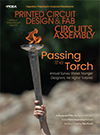News
News
Mixing Alloys on a Single Line
Published: 04 January 2007
by Gerjan Diepstraten
Running SnPb and Pb-free on one line can be done. Here’s how.
What alternatives does a company have to solder Pb-free and SnPb products? Depending on the Pb-free order volume, a company may consider the following:
1. Outsource production until orders for Pb-free designs reach a critical mass.
2. Fill a second solder pot with a Pb-free alloy.
3. Install a second, temporary machine filled with SnPb.
Regarding the second option, most manufacturers employ only one Pb-free alloy. It is highly unlikely a given production environment will employ multiple Pb-free alloys such as SAC, SN100 or SACX (unless customers are asking for specific alloys).
Existing wave solder machines must be upgraded to process Pb-free. The solder pot and inner parts should be Pb-free capable. They should be made from corrosion-resistant materials such as cast iron, titanium or chrome carbide-diffused steel. Conveyor fingers should be constructed of titanium to prevent solder corrosion. Additionally, a finger cleaning system is recommended, since Pb-free solder sticks more easily to the fingers.
Trolley System
A typical temporary solution is to have two solder pots that can quickly be exchanged. Both solder pots should have their own inner parts, heating and pumps to avoid contamination and make fast changeover possible. The most economical approach is to switch alloys at the end of the day, starting with the morning shift the following day.

After swapping the heaters, it takes approximately three hours before the alloy is solidified and the solder pot can be exchanged. For safety reasons, one should never handle liquidous solder. Simultaneously, the second solder pot may be heated outside the machine to a temperature approximately 10° below the melting point so that it remains solidified but already preheated.
After swapping into the machine, reaching set point takes an hour. Overall, the process requires four hours or more; it typically takes four hours to heat solder from ambient temperature to 280°C, and requires 36 kW.
Having two solder pots mounted behind each other in the same machine and underneath the conveyor enables a fast changeover, but comes with additional challenges. The first pot influences preheat, while the second influences cooling. Mixing solder bars and contamination with lead by fingers comes with risk. Extra energy consumption is needed, and debridging tools cannot be used.
Solder contamination. The solder alloy composition will change over time because of copper dissolution. Copper from boards will dissolve much faster in Pb-free alloys as a result of higher solder temperatures and tin content. Every month, a sample of the solder should be examined. Copper, iron and lead content must be monitored.
Dross. Pb-free alloys are more expensive, which puts the focus on dross reduction. Special tools such as dross grabbers, chemicals, recovery systems and hand-cutting applications have been introduced to save as much solder as possible. Nitrogen systems can be retrofitted to reduce dross formation dramatically.
Other considerations. Several other points should be considered as well, including:
- The density and surface tension of Pb-free solder differs from that of SnPb. This requires different settings for the back plate and pump speed; even another wave-former configuration may be necessary to achieve good hole filling.
- Titanium bolts should be used to mount parts in the solder pot area. If not, parts dropped into the solder will sink to the bottom and may damage pump impellers or other parts.
- Floaters for solder level control need small modifications since the alloy density is different.
- Debridging tools (e.g., air knives) may fail in Pb-free applications because the solder solidifies more quickly (soldering temperature versus melting point).
- Adding one bar of SnPb solder into a Pb-free solder pot will increase lead content by 0.3% (where 0.1% is the limit).
- Pallet material should be compatible with higher soldering temperatures.
Gerjan Diepstraten is a senior process engineer with Vitronics Soltec BV (vitronics-soltec.com); gdiepstraten@nl.vitronics-soltec.com. This column appears monthly.
Press Releases
- Free Webinar on “Surface Reliability—Overcoming Challenges in SMT PCB Manufacturing and Determining Root Causes for Improved Performance”
- Indium Corporation Technical Manager to Present on Solder Solutions for Cutting-Edge Solutions for AI and Automotive at SEMICON Taiwan
- PVA Welcomes Rod Kasperson as Global Sales Manager
- Seika Machinery Hosts Second Webinar on Process Control: Advanced Testing and Profiling Techniques







